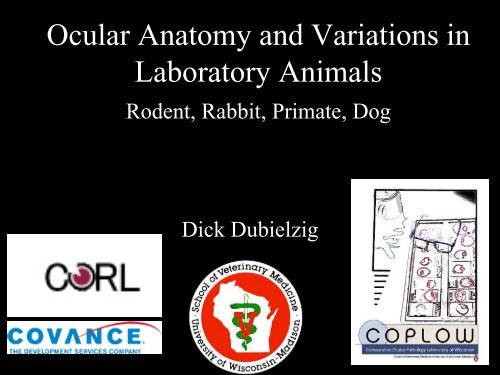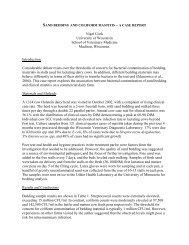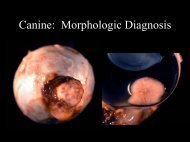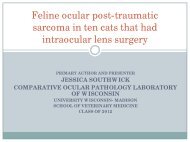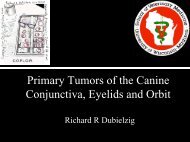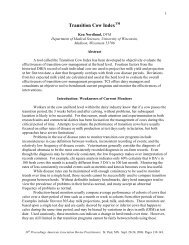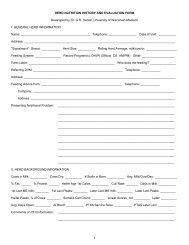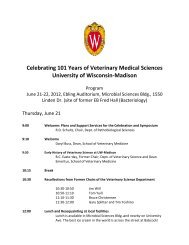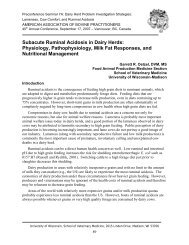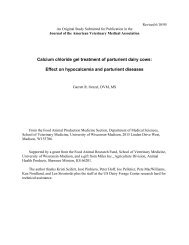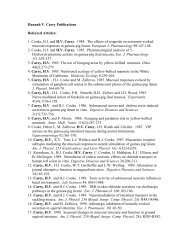Ocular Anatomy and Variations in Laboratory Animals
Ocular Anatomy and Variations in Laboratory Animals
Ocular Anatomy and Variations in Laboratory Animals
You also want an ePaper? Increase the reach of your titles
YUMPU automatically turns print PDFs into web optimized ePapers that Google loves.
<strong>Ocular</strong> <strong>Anatomy</strong> <strong>and</strong> <strong>Variations</strong> <strong>in</strong><br />
<strong>Laboratory</strong> <strong>Animals</strong><br />
Rodent, Rabbit, Primate, Dog<br />
Dick Dubielzig
<strong>Anatomy</strong> is Important<br />
• Is there an adequate body of experience <strong>in</strong> the<br />
species of choice?<br />
• Is the ocular anatomy appropriate for the<br />
procedures to be done?<br />
• What is the best species to answer the question?<br />
• Are there particular anatomic features that might<br />
impact the experimental design?<br />
• What is unique about the ocular anatomy <strong>in</strong> the<br />
different species?<br />
• What are the background lesions <strong>in</strong> each species?<br />
• Alb<strong>in</strong>o vs pigmented
Mammalian<br />
Evolution
Schlemm’s Canal<br />
&<br />
Atapetal Fundus
Rat<br />
Holangiotic Ret<strong>in</strong>a<br />
Merangiotic Ret<strong>in</strong>a<br />
Rabbit
Is there an adequate body of<br />
experience <strong>in</strong> the species of choice?<br />
• Species often used <strong>in</strong> toxicolgy studies<br />
where the eye is a target<br />
– Macaque, Rabbit, Rats of Mice, Dogs<br />
• Species often used <strong>in</strong> basic vision science<br />
research but not toxicology studies<br />
– Cats, Ground Squirrels, Fruitfly, Chicken<br />
• Species be<strong>in</strong>g put forward as hav<strong>in</strong>g<br />
particular advantages <strong>in</strong> toxicology studies<br />
– Squirrel Monkey, M<strong>in</strong>i-pig
Is the ocular anatomy appropriate<br />
for the procedures to be done?<br />
• Is the eye size adequate size for procedures?<br />
• Does the surgical or diagnostic <strong>in</strong>strumentation<br />
work <strong>in</strong> the species?<br />
• Does the ocular anatomy impact drug delivery or<br />
pharmacok<strong>in</strong>etics?
Mouse Eye<br />
Is the ocular anatomy appropriate<br />
for the procedures to be done?<br />
• Is the eye size adequate size for procedures?<br />
– Problems with us<strong>in</strong>g rodents because of the small eye size <strong>and</strong><br />
the <strong>in</strong>accessibility of the vitreous<br />
• Intraocular pressure measurement is not easily done<br />
– Rebound tonometry on tra<strong>in</strong>ed mice or manometry<br />
• Intravitreous <strong>in</strong>jection or sampl<strong>in</strong>g is not easily done<br />
• Diagnostic exam<strong>in</strong>ation <strong>and</strong> procedures require experience <strong>and</strong> tra<strong>in</strong><strong>in</strong>g<br />
that may or may not be automatically available even with board certified<br />
specialists<br />
– Ophthalmoscopy<br />
– Electrophysiology<br />
– Fluoresce<strong>in</strong> angiography
<strong>Ocular</strong> Dimentions<br />
Axial<br />
Length<br />
(mm)<br />
Corneal<br />
Thickness<br />
(mm)<br />
Anterior<br />
Chamber<br />
Depth<br />
(mm)<br />
Lens<br />
Thickness<br />
(mm)<br />
Vitreous<br />
Chamber<br />
Depth<br />
(mm)<br />
Reference<br />
HUMAN 23.92 0.55 3.05 4.0 16.32<br />
MONKEY 17.92 0.55 3.24 2.98 11.3<br />
CAT 22.3 0.68 4.52 8.5 8.13<br />
DOG 20.8 .64 4.29 7.85 10.02<br />
RABBIT 18.1 0.4 2.9 7.9 6.2<br />
RAT 5.98 0.25 0.87 3.87 1.51<br />
A Photon Accurate Model of the<br />
Human Eye, Deer<strong>in</strong>g, ACM Transactions<br />
on Graphics, 2005<br />
A Four-surface Schematic Eye of<br />
Macaque Money Obta<strong>in</strong>ed by An<br />
Optical Method, LAPUERTA, <strong>and</strong><br />
SCHEIN, Vision Research, 1995<br />
The Schematic Eye In The Cat<br />
Vakkur <strong>and</strong> Bishop, Vision Research, 1963<br />
Naturally Occurr<strong>in</strong>g Vitreous<br />
Chamber—Based Myopia <strong>in</strong> the<br />
Labrador Retriever, Mutti, Zadnik, <strong>and</strong><br />
Murphy, Investigative Ophthalmology &<br />
Visual Science, 1999<br />
A Schematic Eye for the Rabbit,<br />
HUGHES, Vision Research, 1972<br />
A Revision of the Rat Schematic<br />
Eye, MASSOF <strong>and</strong> CHANG, Vision<br />
Research, 1972
Rabbit<br />
Is the ocular anatomy appropriate<br />
for the procedures to be done?<br />
• Does the surgical or diagnostic <strong>in</strong>strumentation<br />
work <strong>in</strong> the species?<br />
– Tonometry <strong>in</strong> rodents<br />
– Devises designed for the human eye have to be<br />
retooled to use the rodent model<br />
– Vitrectomy <strong>in</strong>strument: Macaques vs Human<br />
– Choos<strong>in</strong>g the appropriate site for <strong>in</strong>travitrel<br />
<strong>in</strong>jection or aspiration<br />
– Glaucoma dra<strong>in</strong>age devise <strong>in</strong> the rabbit eye<br />
Tonometry<br />
Can<strong>in</strong>e
Is the ocular anatomy appropriate<br />
for the procedures to be done?<br />
• Does the ocular anatomy impact drug delivery or<br />
pharmacok<strong>in</strong>etics?<br />
– The relative % of ocular surface compared to the volume of the<br />
globe is larger <strong>in</strong> rodents than large animals.<br />
– The distance between the ocular surface <strong>and</strong> <strong>in</strong>ternal ocular tissues<br />
is shorted <strong>in</strong> rodents tan large animals.<br />
Can<strong>in</strong>e<br />
Mouse
What is the best species to answer the<br />
question?<br />
• Is a particular model of disease better def<strong>in</strong>ed or<br />
more authentic <strong>in</strong> a particular species?<br />
– Glaucoma models<br />
– Laser models for CNV<br />
– Transgenic mouse models of AMD<br />
• Is a more human-like anatomy <strong>and</strong> physiology<br />
important?<br />
– There is a monkey bias <strong>in</strong> the ophthalmic drug delivery<br />
world because of the marked similarity between monkey<br />
<strong>and</strong> human eyes<br />
• Fovea<br />
• Accommodation<br />
• Outflow<br />
• Lids, tear film, orbital anatomy
<strong>Ocular</strong> Anatomic Features<br />
Dog, Rabbit, Rat & Mouse, Primate<br />
Lacrimal & Hardarian Gl<strong>and</strong>s<br />
Rabbits are able to resist bl<strong>in</strong>k<strong>in</strong>g for<br />
long <strong>in</strong>tervals because they have a very<br />
stable tear film. This is likely due to<br />
the contribution of a lipid contribution<br />
from the prom<strong>in</strong>ent Hardarian gl<strong>and</strong>.<br />
Absent <strong>in</strong> the primate <strong>and</strong> dog.
<strong>Ocular</strong> Anatomic Features<br />
Dog, Rabbit, Rat & Mouse, Primate<br />
Rabbit<br />
Mouse<br />
Eyelid<br />
Can<strong>in</strong>e
<strong>Ocular</strong> Anatomic Features<br />
Dog, Rabbit, Rat & Mouse, Primate<br />
Primate eyelid<br />
Tarsal plate<br />
Human<br />
Macaque
<strong>Ocular</strong> Anatomic Features<br />
Dog, Rabbit, Rat & Mouse, Primate<br />
Fovea<br />
Overall Globe Shape :Primate
<strong>Ocular</strong> Anatomic Features<br />
Dog, Rabbit, Rat & Mouse, Primate<br />
Overall Globe Shape :Can<strong>in</strong>e
<strong>Ocular</strong> Anatomic Features<br />
Dog, Rabbit, Rat & Mouse, Primate<br />
Overall Globe Shape :Rodent
<strong>Ocular</strong> Anatomic Features<br />
Dog, Rabbit, Rat & Mouse, Primate<br />
Primate Vestigial Nictitans<br />
Hairs<br />
Rabbit Nictitans<br />
Rat Vestigial Nictitans<br />
Nictitans (Third Eyelid)
Can<strong>in</strong>e Nictitans<br />
(Third Eyelid)
<strong>Ocular</strong> Anatomic Features<br />
Filtration Apparatus Primate<br />
Schlemm’s Cannal<br />
Scleral Spur
<strong>Ocular</strong> Anatomic Features<br />
Filtration Apparatus Dog<br />
Primary Pect<strong>in</strong>ate<br />
Angular Aqueous<br />
Plexus<br />
Ciliary Cleft
Rat<br />
Rabbit<br />
<strong>Ocular</strong> Anatomic Features<br />
Filtration Apparatus Rat & Rabbit<br />
Schlemm’s Cannal
Accommodation<br />
Ciliary Muscle
Tapetum Lucidum<br />
Eye Sh<strong>in</strong>e Can<strong>in</strong>e<br />
Nontapetal Tapetal Tapetal
Ret<strong>in</strong>a<br />
Fundus<br />
Can<strong>in</strong>e<br />
Primate<br />
Rabbit:<br />
Merangiotic<br />
Rat
Ret<strong>in</strong>a: Primate Macula
Fovea<br />
mERG<br />
Can<strong>in</strong>e Cone<br />
Arrest<strong>in</strong><br />
Primate Cone<br />
Arrest<strong>in</strong>
The Primate Ret<strong>in</strong>a<br />
The Cone Mosaic<br />
Mike Nork
Adaptive Optics
Cone Opso<strong>in</strong>s<br />
Green vs Red<br />
Green vs Blue
The Visual Streak <strong>and</strong> Superior<br />
Ret<strong>in</strong>a<br />
Can<strong>in</strong>e Area Centralis<br />
Rabbit Medullary Ray<br />
Rat Superior Ret<strong>in</strong>a <strong>and</strong> Phototoxic Degeneration
Primate<br />
Optic Nerve<br />
Lam<strong>in</strong>a Cribrosa<br />
Dog<br />
Rat: No Lam<strong>in</strong>a Cribrosa


